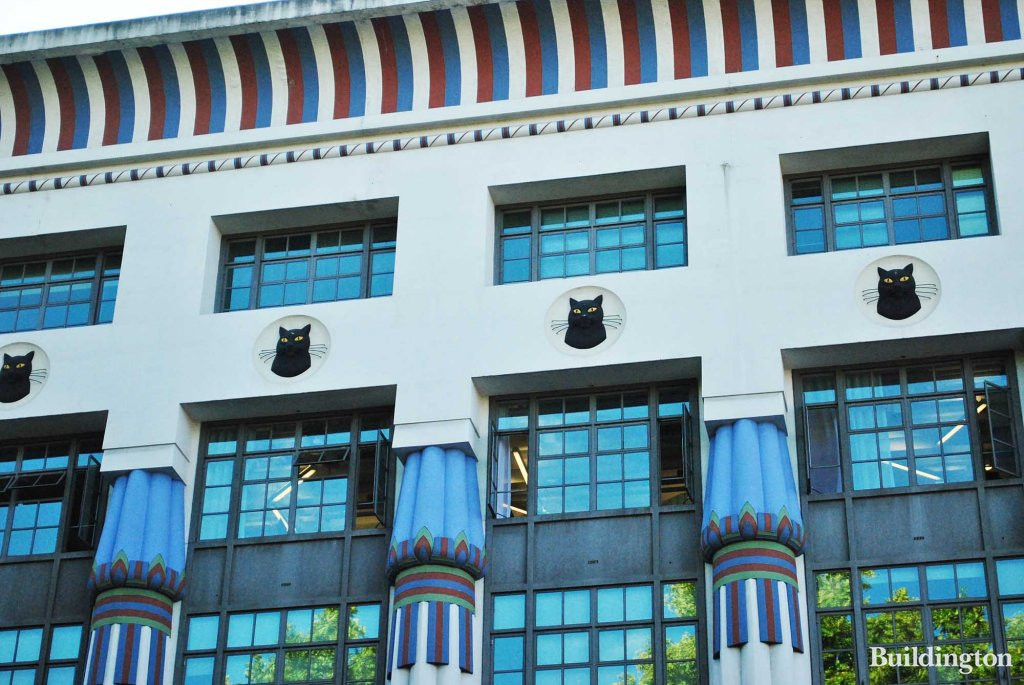Located in the heart of Camden Town, Greater London House is one of London’s most stunning examples of Art Deco architecture. Originally built in the 1920s as a cigarette factory, the building has evolved over the years into a modern office hub while retaining its iconic aesthetic charm.
Whether you’re drawn to architecture, history, or urban design, Greater London House offers a unique perspective into the evolution of London’s commercial and cultural landscape.
A Brief History of Greater London House
Formerly known as the Carreras Cigarette Factory, Greater London House was designed by architects Marcus Evelyn Collins and Owen Hyman Collins and completed in 1928. The building was commissioned by the Carreras Tobacco Company, which sought to create an office and factory space that reflected luxury, power, and modern design.
Inspired by Ancient Egyptian themes—a trend popularized after the discovery of King Tutankhamun’s tomb in 1922—the building features:
- Bold columns and hieroglyphic motifs
- Two large black statues of Bastet, the Egyptian cat goddess
- Ornate ironwork and colorful Art Deco tile patterns
In the late 20th century, the building was refurbished and rebranded as Greater London House, transforming it from industrial use to a prominent commercial office space.
Greater London House Today
Today, Greater London House is a bustling business hub, housing a mix of high-profile tenants in the tech, media, and finance sectors. Notable companies that have operated from the building include:
- ASOS
- Ticketmaster
- Paramount Pictures
The building offers modern amenities, open-plan offices, and is conveniently located just a short walk from Mornington Crescent and Camden Town tube stations.
Architectural Significance
Greater London House is one of the best-preserved Art Deco buildings in the UK. It is recognized for its:
- Striking Egyptian Revival details
- Ornate plasterwork, colorful motifs, and geometric patterns
- Grand façade and symmetrical layout
Its renovation in the 1990s was a critical success, praised for maintaining historical accuracy while modernizing the interiors for practical use.
Location & Accessibility
- Address: 180 Hampstead Road, Camden Town, London NW1 7AW, United Kingdom
- Nearest Tube Stations: Mornington Crescent (1 min), Camden Town (5 mins)
- Nearby Attractions: Regent’s Park, Camden Market, British Library
Whether you’re a local worker or a curious visitor, Greater London House is easy to reach and hard to forget.
Why Visit Greater London House?
- Photography: A must-see for architecture and design lovers
- Historical Value: A living example of 20th-century industrial innovation
- Business Hub: Home to dynamic companies and creative workspaces
- Urban Walks: Close to some of Camden’s best attractions
Conclusion
Greater London House is more than a workspace—it’s a living museum of design, innovation, and transformation. From its Art Deco roots as a tobacco factory to its role today as a cutting-edge commercial hub, the building tells the story of London’s evolution.
Whether you’re planning a trip to Camden, studying London’s architectural history, or just love stunning buildings, this landmark is worth a closer look.
FAQs
1. What was Greater London House originally used for?
It was built as the Carreras Cigarette Factory in 1928, known for its Egyptian-style architecture and massive production capacity.
2. Where is Greater London House located?
Greater London House is in Camden Town, North London, near Mornington Crescent Station and Regent’s Park.
3. Can the public visit Greater London House?
While the interior is primarily office space and not open for public tours, the exterior can be viewed and photographed freely from the street.
4. Why is Greater London House architecturally significant?
It is a rare example of Egyptian Revival Art Deco in London and features decorative elements like Bastet statues, hieroglyphs, and colored glass.
5. Who occupies Greater London House today?
Modern tenants have included companies like ASOS, Ticketmaster, and Paramount Pictures, among others in tech and media.

